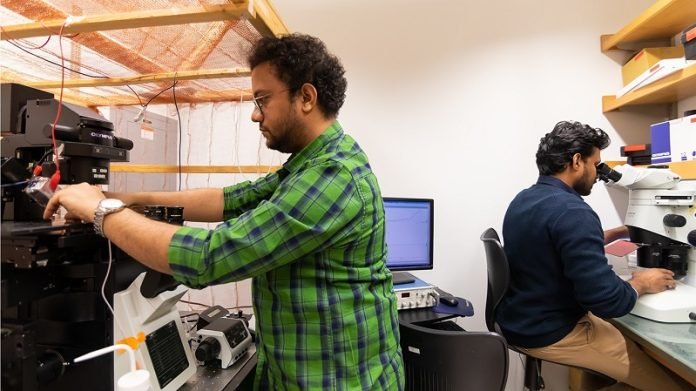
Lysosomes, often reductively referred to as the “garbage disposals” of cells, play a pivotal role in our cells’ digestive systems by getting rid of unwanted materials.
Now in a groundbreaking study, researchers from the laboratory of Prof. Yamuna Krishnan at the University of Chicago have identified the protein responsible for a key role in how lysosomes work: how calcium ions get into lysosomes.
Published in Science Advances, their research represents a significant step forward in understanding the intricate mechanisms underlying lysosomal calcium regulation—and opens new avenues for therapies for diseases that involve lysosome function, including diseases like Parkinson’s or ALS.
Finding the transporter
The function of lysosomes is tightly regulated by complex cellular signals, including calcium ions moving into and out of lysosomes.
Scientists have known how lysosomes release their calcium since their discovery in the 1950s by Christian René de Duve.
What has received less attention is how lysosomes refill their calcium back up.
“Part of the problem has been an inability to measure calcium inside the lysosome,” said Matthew Zajac, PhD’22, the first author of the paper.
“Because it’s a highly acidic compartment, it’s been hard to measure the calcium without that acidity interfering with measurements.”
It wasn’t until the Krishnan lab developed their own pH-correctable sensing device called CalipHluor, a device that can report calcium concentrations in acidic organelles, that the group had a method to accomplish their goal.
Anand Saminathan, PhD’21, a co-corresponding author who played a critical role in developing the research, says, “We knew that calcium is important, but when it comes to the lysosome, we didn’t know which transporter brings the calcium in. However, we felt that technologically, we had everything we needed to figure that out.”
The identified protein may serve as a potential drug target for modulating lysosomal function and mitigating disease pathology at the heart of several common neurodegenerative disorders, such as Alzheimer’s, Parkinson’s, and amyotrophic lateral sclerosis (ALS).
“I think everyone is excited about the addition of an importer, a regulator, to the system,” Saminathan said.
Zajac explains that with “certain neurodegenerative diseases—specifically lysosome storage disorders that have defective lysosomal export mechanisms—the lysosomes end up having too high levels of calcium and they swell up. They get too filled with undegraded material.”
“Current thinking mostly focuses on channel activators,” said Saminathan. “Lysosomes contain numerous calcium channels and modulating that would bring down excessive calcium levels.”
Ultimately the group is optimistic for their research. “We hope to determine that if you could find a way of blocking how lysosomes intake calcium, then you can sort of correct for that defect in export,” Zajac said.
Setbacks, scrutiny, and success
While the group has long been studying lysosomes, their recent determination to confirm the elusive transporter was inspired by a rejected grant proposal.
“On that grant, we proposed to identify lysosomal calcium importers,” Zajac said. “One of the reviewers on that grant said, ‘Well, how do you know there even is one out there to look for?’”
Motivated by the criticism, the lack of a provable transporter set the group on a path to refine their findings and push the boundaries of their expertise.
Despite what Zajac calls “a grueling couple of years,” Saminathan gives credit to Prof. Yamuna Krishnan as the driving force behind the project, inspiring and motivating her team to persevere through setbacks and scientific scrutiny.
In a transparent move not often found in the field, Professor Krishnan herself publicized the pangs of their research process, documenting their perseverance in a “tweetorial” that reveals what goes on behind the curtains of scientific determination.
“For me at least, it was easy to get disappointed when we would hear tough feedback from reviewers,” said Zajac, “but she would always push us to address the tough comments and submit again, not giving up.
She really both pulled and pushed this thing forward. Especially with this work, we used so many different types of experiments and had expertise from so many different people that were important to the research, it was a team effort led by her motivating us.”
Having found a crucial piece of the puzzle in lysosomal calcium regulation, the researchers aim to delve deeper into the mechanistic intricacies of the identified protein and explore additional lysosomal calcium transporters.
Written by Brian Foley/University of Chicago.



